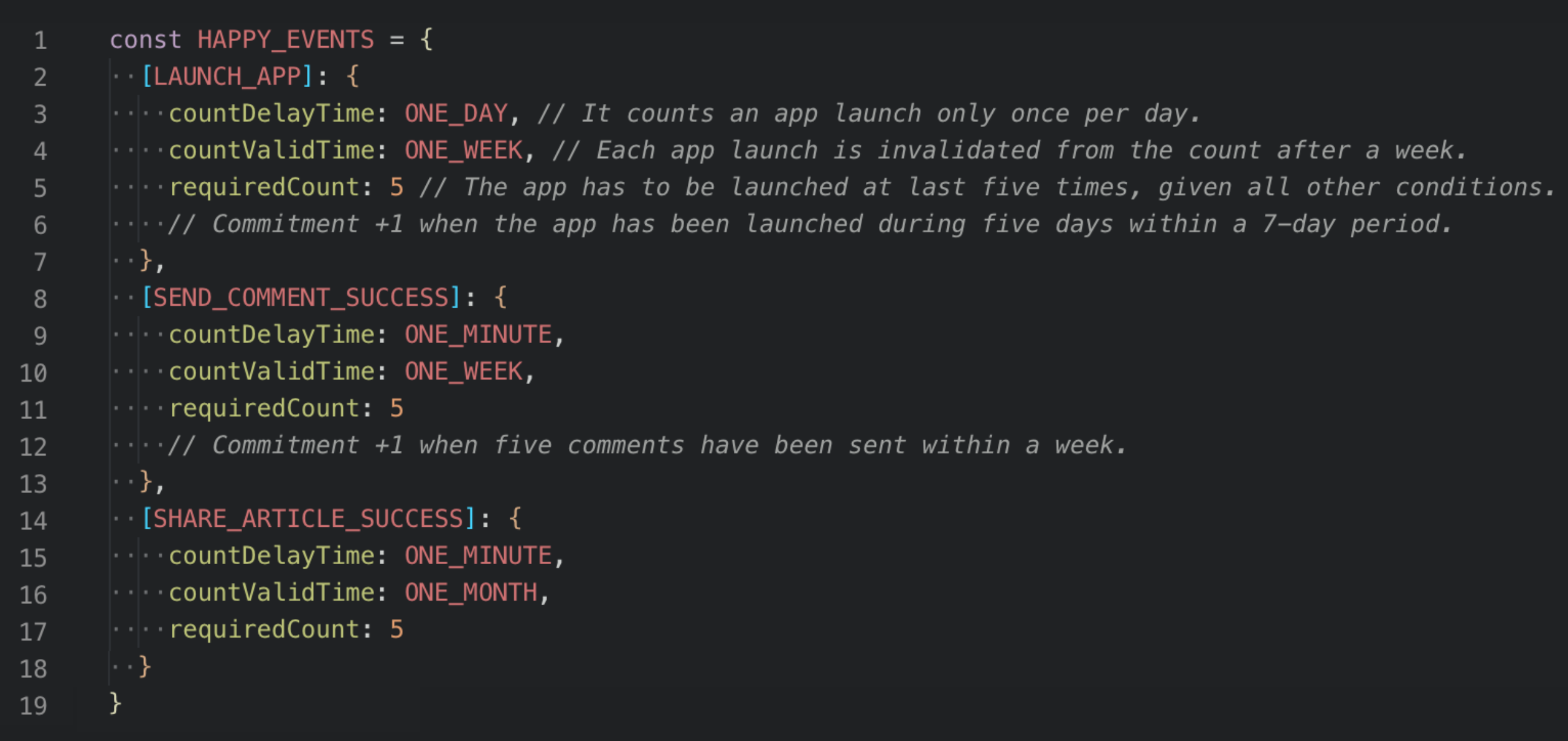
How many stars does your app have?
Here’s everything you need to know about app ratings, a few simple tricks to combat rating entropy, and how to build a system to find your valued users and bring home those golden 5-star ratings.
Here’s everything you need to know about app ratings, a few simple tricks to combat rating entropy, and how to build a system to find your valued users and bring home those golden 5-star ratings.
An app’s star rating affects conversion significantly and shouldn’t be ignored. Unfortunately, the rating is often seen as an uncontrollable end result rather than an integral feature the development team should take responsibility for. Those who take action often apply small band-aids to give the rating a boost, when a consistent systemic approach could make all the difference.
Here’s how to hack the ratings and rack the hatings.
The fight for space
People rarely install new apps and tend to stick with only a few. Only about 65% of people install a new app every 30 days[1].
Furthermore, the average person uses 9 apps in a day, and only 30 in a month[2]. Getting into that space isn’t easy, and the competition is brutal with over a million apps in Google Play and more than 200,000 in AppStore.
Both Google Play and AppStore rank apps with more and better ratings higher[3]. People are also much more likely to install higher-rated apps. Only about 50% of people are willing to install an app with a 3-star rating, while almost everyone will install a 4-star one[4].
Besides app ratings, written reviews also hold significant value. Roughly 79% of people check both the rating and reviews before installing an app, 53% even before an update. Four out of ten consider written reviews at least as trustworthy as personal recommendations[5].
Improving an app’s rating from 3 to 4 stars is expected to increase store conversion by a staggering 89%[6]. When it all comes together, an app’s rating is extremely important and signals not only the current but also the future success of the app.
Ratings don’t always reflect app quality
When an app’s rating is poor, the usual course of action is to push the development team to “make the app better”. But what if I told you an app’s quality may have little to do with its rating? In fact, few apps have a good rating without actively cultivating it.
There are many reasons why a perfectly functioning app might be rated low.
Different demographics may have varying rating behavior. For example, if you look at the rating and reviews of Yle Kids Areena, a Finnish video content app for children, the tone is overwhelmingly positive when compared to similar apps targeted at adults, like its counterpart Yle Areena or Netflix.
Sometimes an app’s brand can be a curse as well as a blessing. For example, Facebook’s app rating on iOS App Store is a measly 3.1 stars. This may reflect the declining public image and popularity of the service in recent years.
Large public entities typically suffer from similar stigma, as categorical opposition always finds its way. Turns out catering to everyone is hard.
If an app solves a simple problem for a narrow user base, the users may be happy with little. One such example is Aamukasaaja with its impressive rating of 4,5 stars on Google Play.
Aamukasaaja visualizes the days of military service left for any individual Finnish Defence Forces conscript. The app has a clear value proposition and is popular for delivering on it, clean and simple.
Hacking app ratings
People are more likely to rate an app after a negative experience than a positive one[5]. Thus, if the rating isn’t cultivated, it will slowly deteriorate. Each crash, bug or mistake will be written in the stars, accumulating rating entropy.
If you have only the odd hour or two to spare, consider the following measures to alleviate rating entropy.
- Respond to your store reviews. Be honest and polite. This is the easiest way to turn a 1-star rating into a 5-star one.
- Provide your own feedback channel. Include a link within the app. This way people are more likely to give their constructive feedback through a channel you have better control over.
- Reset the rating (iOS). If your app’s AppStore rating is historically poor and you’re confident your shiny new update will turn the tide, resetting the rating altogether may be the right move. This provides a fresh start but also hides an underlying risk – the new rating may become even worse since most of your loyal users have probably given their good word already. Neither are Android apps doomed to carry the burden of past mistakes forever. Google Play will start giving greater weight to recent ratings from August 2019[7].
- Meet expectations. If your app doesn’t provide the value it promises, people will feel betrayed. Changing an app’s value proposition or functionality completely is probably too ambitious, but humbling down the initial marketing message can go a long way.
- Fix pressing issues. A great app may have only a few stars, yet a bad app will never have many. Read your app’s reviews to find the gripes of your users and fix the most recurring ones. While this won’t make the rating better, it will combat rating entropy in the long run.
- Ask for a rating. Nothing beats a humble request. This can backfire catastrophically if not done well, however, blotting out the little starlight your app may already have.
The road to stardom: a systemic approach
There really is only one solid approach for making a continuous and lasting positive impact on app rating: find the people willing to give a 4- or 5-star rating, and ask them to do so. Luckily, you can build a system to track user loyalty to this end.
The ultimate goal for a system like this is twofold:
- Get more people to download the app, by displaying a higher app rating.
- Get more and better reviews from loyal users.
We piloted the systemic approach in one of our mobile Android & iOS app cases with about 40,000 weekly users at that time. The results after the update were stellar.
- More ratings in two weeks than in the whole year the app had been available.
- The iOS rating jumped from 2.7 to 4.2 in two weeks, after a rating reset.
- The Google Play rating increased from 2.9 to 3.6, and keeps climbing.
- Multiple requested features or fixes implemented on the basis of detailed reviews from loyal users.
The star machine
Let’s take a look at how you can create your own system and stop worrying about app ratings forever. It should not take longer than 1–2 weeks, so you can even do it within a typical sprint.
First, plan what you’re doing. Find the critical moments when the user is happy with your app. Let’s call these your app’s happy events. These could be, for example, commenting on an article, reading through an entire article, saving a recipe into a personal recipe book, or using a discount coupon for a purchase.
Ask yourself, your team and even your users questions like “What problem does this app solve for you?” or “What do you open the app for?”. Also study the analytics, assuming you have some level of data maturity, and try to find the most used and well-liked actions within the app.
When the happy events have been identified, you’ll need to configure them with a few key variables to determine their contribution towards an abstracted value describing user loyalty.
- A count of how many times the event needs to trigger to increase user loyalty.
- A delay required between two similar events for them both to be counted.
- A validity for how long an event should increase user loyalty.
For example, just opening the app could be a happy event, but you may want to count it as increasing loyalty only if the user opens the app on five (count) days (delay) in a week (validity).
The abstracted user loyalty value doesn’t need to have a validity time itself. You can trust the loyalty of a user who proved themselves up to a month ago and came back.

An abstract example of happy events configuration.
Now that you have a model for happy events, write the necessary functions to track and preserve the user’s activated happy events and ensuing loyalty. Make sure you also gather analytics from each action for future reference. If you can, host the happy events configuration online, so that you can tweak it on the fly.
Ask and you shall receive
With the machinations for happy event and user loyalty tracking in place, you should next configure a feasible loyalty threshold to asking for a rating. This can be anything from 2 to 7 or even more. The right amount depends on your app, your users and the amount of different happy events configured.
Asking for the rating is an art of its own. Typically, you’d want to create a custom modal, toast message or a notification linking to the app’s store page. For iOS users with version 10.3 or later, you should use the built-in OS review dialog. Just remember that you won’t know whether the dialog was shown, but it’s almost guaranteed to be displayed on the first attempt.
Regardless of the method, make sure it’s triggered either only once per user, or very rarely after the first try. Having an option to ask again later can bring in a few more reviews, but the volume and impact of high ratings is primarily generated by the users who will give 5 stars on the first try.
Keep in mind that a high user loyalty score doesn’t necessarily mean it’s the best time to ask for a rating. It’s worth it to sprinkle triggering events within the app’s usage flow that signify the user isn’t in the middle of something, such as a game or writing something.
It also doesn’t hurt to configure the rating request to only show when the user has recently, perhaps within the last 5 minutes, completed any happy event. These safeguards make sure your timing is perfect and the user is most willing to consider giving a high rating.
Shoot for the moon
When your system is ready and tested, release it and see how it fares in the wild. If you haven’t gotten more ratings after a while, your configuration may be too strict. If you get more ratings but the average isn’t any better, you might want to tighten your configuration to only find the truly loyal users.
There’s also a risk you might be tracking the wrong events. Regardless of this, use your newfound information to tweak and test the configuration to find the perfect balance of a high rating score and volume.
Starstruck already?
A good app rating is just one cog in the marketing machine, but it’s something the development team can, and should, take ownership of. And how proud can you be when, instead of having made a two-star app, four glimmering shinies greet you at the app store instead.
If you’d be interested in hearing more about how to increase your app’s rating, give us a holler and we’ll be sure to get back to you!
Illustration: Aija Malmioja
References
-
- New App Usage Report: How Many Apps Do Users Install a Month? https://www.appannie.com/en/insights/market-data/new-app-usage-report-how-many-apps-do-users-install-a-month/
- Report: Smartphone owners are using 9 apps per day, 30 per month https://techcrunch.com/2017/05/04/report-smartphone-owners-are-using-9-apps-per-day-30-per-month/
- Deconstructing the App Store Rankings Formula with a Little Mad Science https://moz.com/blog/app-store-rankings-formula-deconstructed-in-5-mad-science-experiments
- The Guide to Mobile App Ratings & Reviews https://go.apptentive.com/rs/170-TZF-108/images/2016GuideToMobileAppRatingsReviews.pdf
- The Psychology of App Store Ratings & Reviews https://go.apptentive.com/rs/170-TZF-108/images/PsychologyofAppStoreReviews_Infographic.pdf
- The Average Mobile Apps’ Ratings and Reviews, by Category https://www.apptentive.com/blog/2016/10/20/average-mobile-apps-ratings-and-reviews-by-category/
- Google Play is changing how app ratings work https://techcrunch.com/2019/05/08/google-play-is-changing-how-app-ratings-work/



